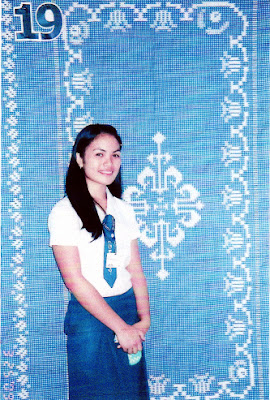 |
| A charming Hawaiian dancer. |
Just when everyone thought summer is fast-fading, the banana
capital of the south splurges a colorful and artistic flair to end kids,
youngsters and parents’ 2010 summer experience.
As hot as the feverish summer temperature, performances of
Curay Dance and Arts Workshop (CDAW), Panabo City ’s
premiere dance and arts studio, elevate a notch higher.
The jam-packed Panabo gymnasium and the excited crowd were a
witness to the grace, style and creative choreography as the workshop graduates
pay tribute to classic Disney themes, modern beats and Broadway musicals in various
dance acts.
 Unlike others, this was not just another summer workshop. CDAW
dance and art classes have become a recognized dance institution in the area
with 22 years of training and workshop experience under its belt.
Unlike others, this was not just another summer workshop. CDAW
dance and art classes have become a recognized dance institution in the area
with 22 years of training and workshop experience under its belt.
The Dances
This year’s recital is themed Dance Reload. The center stage
is once again loaded with fresh talents, new discoveries and developing
potentials among the 180 workshop graduates who grabbed the spot light.
 | |
| Chicago Remake. A scene from the musical "Chicago." |
Each dance category shining one from another as performers
as young as two and as old as 42 years old gracefully strut their stuff.
The audience wowed to the ballet skills of the kids enrolled
in baby and advance ballet classes to the interpretation and tribute to Disney’s
princesses Snowhite, Ariel of Little Mermaid, Jasmine of Aladdin, and Belle of
Beauty and the Beast.
The fluid hip sway exaggerated by the smooth ripple of the
colorful grass skirts accentuating the bewitching Hawaiian dancers charmed the
crowd.
And then there was jazz. Their remake of some of the most
memorable parts of the Catherine Zeta-Jones’ hit musical Chicago was as passionate and as artistic as the
original.
Never to be outshined was the energy of the modern genre of
hip-hop dancing. What with futuristic
costume and heart stumping arrangement of today’s hottest beats the hip-hop
dancers exploded like real bombs.
While the sensuous and energetic belly dancing and
Dancesport were equally enthralling performances.
Teakwondo and Dancexercize
As a sport for all sexes and ages, taekwondo has its own
string following. The martial art was featured as defensive rather than an
offensive skill. While dancexercise
showed a body-toning activity from the combined impacts of the dancing and
exercise.
Darling: Panaobo’s
mother of performing arts
“It’s the same excitement and enthusiasm year after year,” enthused
Darling Curay, CDAW owner and over-all aesthetic director.
Her management degree from Ateneo de Davao University might
have been put aside in awhile when she opened the studio in March 1988 to give
way to her heart’s desire for performing arts.
Darling, as she is popularly known, said because there were
no performing schools before, her various dance trainings with well-known
performers, exposures in stage and theater and additional degree in Physical
Education beefed up her credential as performing artist.
“As with my experience in CDS, this is not as profitable as
the other well-known dance schools (in nearby Davao City ),”
Nanay Darling, as she is fondly called, told this writer.
“It’s all for the love of performing arts and my vocation to share my talents together
with my other dance instructors which makes the blood-life of this studio,” Darling
added.
 |
| An advance ballet student shows how penche is done. |
CDS’ students are aplenty during summer classes. That’s why
she focused classes during this period. Although trainings are conducted in
some other time of the year, but mostly the studio is lent to her dance
scholars for their practices especially during seasons of competition.
“Our main objective is to nurture, develop and enhance the
ability and talent of every individual and inculcate in our students
appreciation and valuing of art and the artist,” she said.
She said every year they are faced with the perennial
problem of finding sponsors, one reason why in some years they did not have
grand recital. It was only in the recent past people started noticing and
eventually appreciated their efforts in performing arts.
“I think we have the most affordable dance lessons. But I
always make sure that the studio hires the best dance instructors to provide
quality training each year,” she proudly said.
“I am just thankful that my family is supportive of me as
well as to all my dance instructors who share in my passion (for performing),”
Darling said.
Surely as Dance Reload has shown, this banana capital in the
south, a potassium rich-city has worked up its muscle to have an overload of
dancers and performers.
And without doubt, the 2010 summer dance and arts workshop
of Curay Dance Studio will be poignantly etched to memory even for a lifetime.





